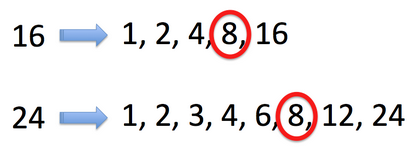Greatest common factor
The greatest common factor of two or more numbers (also called the greatest common factor or the highest common factor or the greatest common divisor) is the largest number that gives an integer as a result when both numbers are divided by it. The easiest way to calculate the GCF of two numbers is to list all the factors of those numbers and choose the ones they have in common. The largest of those factors is the greatest common divisor. For example, let us look at the numbers 27 and 45 and calculate their GCF. The number 27 can be divided by numbers 1, 3 and 9. The number 47 is divisible by numbers 1, 3, 5, 9 and 15. The divisors they have in common are 1, 3 and 9. The largest of them is 9 and it is their greatest common divisor. It is also possible to calculate the GCF by using prime factorizations and determining how many factors the two numbers have in common. The shared factors are then multiplied and the result is the GCF. For example, the prime factors of number 64 are 2*2*2*2*2*2 and the prime factors of number 72 are 2*2*2*3*3. The factors they have in common are 2*2*2. So, after we multiply these factors we get 8 as the result and ther greatest common factor. This method is only practical for smaller numbers, since prime factorization of large numbers takes a lot of time.
The GCF is particularly useful when it comes to simplifying fractions. The ration between the numerator and the denominator in a fraction does not change if you divide both numbers with their GCF, but the procedure makes bulky fractions easier to calculate with.
Example: Number 12 will give an integer as a result when it is divided by numbers 1, 2, 3, 4, 6 and 12. Number 18 can be divided by 1, 2, 3, 6, 9 and 18. That means that the largest common factor of the numbers 12 and 18 is 6, since 12 cannot be divided by 9 and 18 and still give an integer as a result.
The greatest common factor is especially useful for the reduction of fractions to their lowest terms. It is done by dividing both the numerator and denominator with their greatest common factor, thus finding an equivalent fraction in which the numerator and denominator are as small as they can possibly be.
Example: We want to reduce the fraction 14/21 to its lowest terms. Number 14 (the numerator) can be divided by 1, 2, 7 and 14, while 21 can be divided by 1, 3, 7 and 21. We can see that the greatest common factor of the numbers 14 and 21 is 7. By dividing both 14 and 21 with 7, as a result we get the fraction 2/3 which is equivalent to the fraction 14/21.

Greatest common factor exams for teachers
| Exam Name | File Size | Downloads | Upload date |
|
Integers
|
|||
| Greatest common factor of integers – very easy | 152.5 kB | 6490 | September 3, 2019 |
| Greatest common factor of integers – easy | 553 kB | 6501 | September 3, 2019 |
| Greatest common factor of integers – medium | 546.2 kB | 8675 | September 3, 2019 |
| Greatest common factor of integers – hard | 548.2 kB | 5306 | September 3, 2019 |
| Greatest common factor of integers – very hard | 534.1 kB | 4999 | September 3, 2019 |
|
Monomials
|
|||
| Greatest common factor of monomials – very easy | 571.3 kB | 4697 | September 3, 2019 |
| Greatest common factor of monomials – easy | 552 kB | 5627 | September 3, 2019 |
| Greatest common factor of monomials – medium | 566.6 kB | 6609 | September 3, 2019 |
| Greatest common factor of monomials – hard | 545.7 kB | 4605 | September 3, 2019 |
| Greatest common factor of monomials – very hard | 547.9 kB | 4176 | September 3, 2019 |
Greatest common factor worksheets for students
| Worksheet Name | File Size | Downloads | Upload date |
| Greatest common factor integers | 144.2 kB | 6153 | September 3, 2019 |
| Greatest common factor monomials | 257.6 kB | 7220 | September 3, 2019 |